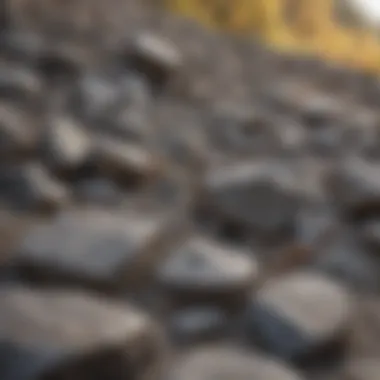Granite Pictures: A Comprehensive Exploration of Granite


Intro
Granite is not merely a rock; it forms the very foundation of our planet's surface. As an igneous rock, granite is primarily composed of quartz, feldspar, and mica, giving it a distinctive appearance. Its geological significance is profound, influencing everything from architecture to art. This article will unfold the various dimensions of granite, showcasing its types, textures, and cultural impact—while offering a diverse selection of granite images to enrich understanding.
One key aspect is the geological processes that lead to the formation of granite. It comes from the slow crystallization of magma beneath the Earth's surface. This lengthy process creates large, visible crystals, granting granite both strength and beauty. As we delve deeper, readers will gain insights not only into granite's fascinating origins but also into its modern applications and aesthetic qualities.
The following sections explore selected facets of granite. From collectible varieties to identification techniques, we aim to offer valuable information for both novices and experienced rock and fossil collectors.
Preamble to Granite
Understanding granite is essential in the context of geology and the broader scope of natural materials. This section lays the foundation for appreciating granite not just as a rock, but as a complex product of geological processes with significant cultural and practical implications. By exploring its definition, composition, and formation processes, readers will gain insights that enhance their knowledge and appreciation of this remarkable material.
Definition and Composition
Granite is an igneous rock primarily composed of three minerals: quartz, feldspar, and mica. These minerals are what give granite its characteristic appearance. Quartz contributes to the rock's hardness and chemical resistance, while feldspar is crucial for its aesthetic appeal, offering a range of colors that can include pink, white, and gray. Mica, on the other hand, plays a role in the rock's texture, providing it with a sparkling quality that is aesthetically pleasing.
A key aspect of granite's definition is its formation from magma. When magma cools slowly beneath the Earth's surface, it allows for the growth of large mineral crystals, a process called slow cooling. This is why granite has a coarse-grained texture. Additionally, the specific proportions of its constituent minerals can vary, leading to a wide variety of granite types, each with unique colors and patterns.
Formation Processes
Granite formation is a complex phenomenon that begins deep within the Earth’s crust. The primary process is called crystallization, which occurs when magma cools gradually over time, typically in large, underground magma chambers known as batholiths. The cooling rate is vital; a slow cooling process results in larger crystals, while rapid cooling leads to finer-grained rocks such as basalt.
Once formed, granite can be exposed through tectonic forces that uplift the granite to the surface, often through erosion of overlying materials. This process can take millions of years and significantly impacts the landscape, creating features like mountain ranges and plateaus.
Overall, understanding the definition and formation of granite is fundamental for anyone interested in geology or rock collecting. These insights not only provide context for the rock's varied appearances but also for its widespread use in construction and art.
"Granite, with its unique composition and formation processes, serves as a testament to the dynamic nature of Earth’s geology."
This knowledge paves the way for a more profound appreciation of granite in our daily lives, from building structures to its role in the natural environment.
The Geological Background of Granite
Understanding the geological background of granite is crucial for appreciating its place within the natural world. Granite is not just another rock; it is a fundamental component of the Earth's crust. This section elaborates on how granite fits into the broader geological context, thereby enhancing the reader's insight into its significance and the factors that contribute to its formation.
Granite in the Rock Cycle
Granite plays an essential role in the rock cycle, which describes the continuous transformation of rocks through various geological processes. As an igneous rock, granite originates from the slow crystallization of magma beneath the Earth's surface. During its formation, minerals such as feldspar, quartz, and mica crystallize, creating the coarse-grained texture characteristic of granite.
Once granite is exposed to weathering and erosion, it can break down into smaller particles, contributing to soil formation. Over time, these particles are compacted and cemented, forming sedimentary rocks. The cycle does not end there, as these sedimentary rocks can undergo metamorphism under intense heat and pressure, producing metamorphic rocks. Consequently, granite serves as a vital link in the rock cycle, exemplifying the interconnectedness of geological processes.
Common Locations of Granite Formation
Granite is predominantly found in continental crust, and its formation is often associated with tectonic activity. There are several notable locations around the world where granite is prevalent:
- Sierra Nevada, USA: Famous for its breathtaking landscapes and landmarks like Yosemite National Park, this region showcases vast granite formations shaped by glacial activity.
- Canadian Shield: This area consists of ancient granite that forms the bedrock of much of Canada and parts of the northern United States. Its extensive outcrops are essential for understanding the geological history of North America.
- The Scottish Highlands: Renowned for stunning granite peaks, this region demonstrates how erosional processes have exposed granite formations, revealing their complex history.
The study of these locations is important as it helps researchers understand not only the geological history of the Earth but also the various processes that contribute to granite formation. By examining these areas, rock and fossil collectors can better appreciate the diversity and significance of granite in Earth's geological narrative.


"Granite is not just a rock; it is a historical record of the Earth's geological evolution."
Gaining insight into the geological background of granite enriches our understanding of this fascinating material and its role in the natural world. As we explore granite further in this article, we deepen our appreciation of its beauty, significance, and enduring presence in our planet's landscape.
Types of Granite
Understanding the Types of Granite is essential for comprehending this multifaceted material. Granite is not uniform; it presents a variety of forms that arise from different geological processes and mineral compositions. This section provides valuable insight into igneous and metamorphic granites and distinct varieties such as Alkali Granite, Syenite, and Granodiorite. Each type carries its own attributes and application potentials.
Igneous Vs. Metamorphic Granites
Granites are primarily classified as igneous rocks, formed from cooled molten magma. This classification makes them inherently distinct from metamorphic rocks, which arise from the transformation of existing rocks due to heat and pressure.
- Igneous Granites are typically characterized by their grainy texture and variety of colors, reflecting the minerals they contain. They form slowly underground, allowing large crystals to develop. These granites are essential for an understanding of many geological processes, as they represent cooling and solidification of magma.
- Metamorphic Granites involve a different journey. They start as igneous rocks and undergo metamorphism, leading to changes in mineralogy, texture, and structure. This process can create unique aesthetic features. Understanding these differences is vital for collectors and enthusiasts, as it impacts the identification and valuation of granite specimens.
Distinct Granitic Varieties
Granite can be further categorized into distinct varieties, each with special characteristics and uses. The more notable varieties include Alkali Granite, Syenite, and Granodiorite.
Alkali Granite
Alkali Granite is notable for its high content of alkaline minerals, particularly sodium and potassium. This gives it a unique color palette that often includes pinks and light reds.
- Key Characteristic: Alkali Granite is less dense than other varieties, which can make it more workable for sculpting.
- Benefits: Its aesthetic appeal and lighter weight make it a popular choice in both commercial and artistic applications, specifically in architecture and monuments.
- Disadvantages: However, its susceptibility to weathering can limit its long-term durability in outdoor situations.
Syenite
Syenite differs from granite primarily in its lack of quartz content, making it more similar to diorite. It is composed mainly of feldspar and is often light in color.
- Key Characteristic: The absence of quartz results in a more uniform texture and appearance, making it visually distinct and appealing.
- Benefits: Syenite can be less prone to water absorption, making it a durable choice for certain constructions.
- Disadvantages: Its lesser-known status compared to granite may result in difficulties in sourcing for collectors.
Granodiorite
Granodiorite is a hybrid between granite and diorite, containing much of quartz alongside feldspar and biotite. This results in a rich, speckled appearance.
- Key Characteristic: The varied mineral content provides a balance between the lightness of granite and the darker features of diorite.
- Benefits: It is valued for its beauty and durability, making it suitable for both commercial countertops and large architectural projects.
- Disadvantages: Because of its composition, granodiorite can be more difficult to work with during fabrication compared to pure granites.
Understanding these types of granites not only increases appreciation for this natural material but also aids in informed decision-making for collectors and enthusiasts.
Each type of granite offers something unique, whether in form, function, or aesthetics. This knowledge contributes significantly to the appreciation and responsible collection of granite specimens.
Granite Pictures: A Visual Analysis
The study of granite pictures offers a unique lens through which we can appreciate this enduring material. Visual representation does more than just capture the aesthetic qualities of granite; it delves into its geological history and physical characteristics. For collectors and enthusiasts, granite images are not merely pretty visuals; they serve as a critical tool for identifying different varieties and understanding their formation processes. This section emphasizes the significance of photography in documenting granite specimens, showcasing their unique textures and layers, and ultimately enriching our appreciation of granite.
Photographic Techniques for Granite
Photographing granite effectively requires a sound understanding of both the material and the techniques involved. The following points are essential for capturing granite pictures that convey both beauty and detail:


- Lighting: Natural light is often the best option. Soft, diffused light helps minimize harsh shadows and brings out the subtle variations in color and texture.
- Angles: Photographing granite from various angles can showcase its depth and unique formations. Experimenting with different perspectives provides a more comprehensive view of the piece.
- Macro Photography: This technique can capture intricate patterns and textures that may not be visible from a distance. Close-up shots reveal details such as mineral inclusions and grain structure.
- Background: A neutral background minimizes distractions and allows the granite to stand out. Using materials such as white cloth or grey card can enhance visual clarity.
These techniques serve to document granite specimens not just as objects but as pieces of nature’s art, revealing the complexity and beauty inherent in this rock.
Showcasing Textures and Layers
Textures and layers in granite tell stories of geological processes over millions of years. Analyzing these features is critical for both understanding the rock itself and for appreciating its visual appeal. Here are some aspects to consider when capturing or examining the textures and layers in granite:
- Grain Size: The size of the mineral grains can vary greatly. Fine-grained textures are often linked to rapid cooling, while coarse-grained structures indicate slower cooling processes.
- Layering: Rock layers can reflect historical events, such as shifts in the Earth’s crust. Capturing these layers on camera can provide insights into the geological history.
- Color Variations: Different minerals within the granite contribute to its color, creating patterns that can be very striking. Photographs highlighting these variations can educate the viewer about the granite’s composition.
- Surface Features: Features such as striations, pits, and weathered areas add depth to granite images. Documenting these characteristics enhances their aesthetic and educational value.
By focusing on textures and layers, granite pictures not only celebrate the physical beauty of this rock but also act as educational tools, informing others about the geological processes that create such wonders.
"Each image of granite embodies not just a snapshot of a rock, but a unique narrative waiting to be explored."
Through careful photographic techniques and attention to detail, enthusiasts can capture and share the intricate beauty of granite, enriching their own understanding and that of others.
Cultural and Historical Significance
Understanding the cultural and historical significance of granite reveals not only its physical characteristics but also its impact on human civilizations. Throughout history, granite has been utilized as a durable material in the construction of landmarks, monuments, and even tools. Its resilience against natural elements has made it a preferred choice for builders and artisans across various cultures.
Granite in Ancient Civilizations
Ancient civilizations recognized the value of granite quite early. In Egypt, granite was integral to architectural marvels like the Great Pyramid of Giza and the Sphinx. The Egyptians utilized advanced quarrying techniques to extract granite and transport it across the Nile. They shaped this stone into blocks that adorned temples and carved monumental statues, showcasing both the material's strength and their craftsmanship.
In addition to Egypt, granite also played a pivotal role in Roman architecture. The Romans used it in structures like the Pantheon and the Colosseum, where its sturdiness contributed to the longevity of these iconic sites. The Roman advancements in construction greatly influenced the use of granite as a popular building material in Europe during the Renaissance period, confirming its lasting cultural relevance.
Modern Uses of Granite in Architecture
In contemporary society, granite continues to hold an esteemed place within architecture. It is frequently used in the construction of commercial buildings, countertops, and memorials. The modern preference for granite stems from its aesthetic qualities and versatility. Available in numerous colors and textures, granite allows for creative expression in design.
Notably, the Vietnam Veterans Memorial in Washington D.C. features black granite as a tribute to those who served. This memorial reflects how granite not only serves functional purposes but also carries emotional significance, connecting people to history and memories.
Granite's role in modern architecture extends beyond mere aesthetics. It is a sustainable choice due to its durability, reducing the need for frequent replacements. By incorporating granite into construction projects, architects and builders promote environmental responsibility while enhancing the visual impact of their designs.
"Granite has transcended time, style, and function; it remains a testament to human creativity and resilience."
Culmination
Collecting Granite Samples
Collecting granite samples offers an opportunity for rock enthusiasts and geologists alike to engage with the material on a physical level. This section emphasizes why gathering granite is significant. Granite is not merely a decorative stone; it holds vital information about geological processes and the history of Earth. By studying granite samples, collectors can gain insights into the conditions under which the rock formed. Specimens can also serve educational purposes, providing tactile experiences that illustrate the diversity of geological formations.
Identification Techniques
To effectively collect granite samples, understanding identification techniques is crucial. Granite can often appear deceptively similar to other igneous rocks. Here are some key points to aid in accurate identification:
- Coloration: Granite typically exhibits a speckled appearance, consisting of various minerals such as quartz, feldspar, and mica. The colors can vary widely, from pink to gray, depending on mineral composition.
- Texture: The texture of granite is generally coarse-grained. Observe the size of the crystals; larger crystals usually indicate a slower cooling process.
- Mineral Composition: Use a hand lens to examine the minerals within the granite. Identifying quartz, feldspar, and biotite will help verify it as granite.
- Weight and Density: Granite is heavy for its size due to its mineral content. This can be a simple test when identifying samples.


These methods can enhance the precision of sample collection and ensure that the granite acquired is genuine and representative of the area's geology.
Preservation Methods
After collecting granite samples, preservation is essential to maintain their structural integrity and prevent decay. This section explores several practices for preserving granite samples effectively:
- Cleanliness: Remove any dirt or debris immediately after collection. Use a soft brush to gently clean the surface without damaging the rock.
- Drying: Ensure that the samples are thoroughly dry before storage to prevent moisture-related decay or mineral alteration.
- Storage Environment: Store granite samples in a cool, dry place with stable temperature and humidity levels. This helps avoid any potential chemical reactions that can occur in fluctuating environments.
- Display Considerations: If showcasing samples, consider using UV-filtering glass to minimize exposure to harmful light, which can cause fading or deterioration over time.
- Documentation: Keep records on collection location, date, and any specific observations noted during collection. This information can be invaluable for future reference.
Collecting and preserving granite samples not only enriches personal collection but also contributes to a broader understanding of geological history and formation processes.
Environmental Impact of Granite Quarrying
The quarrying of granite is a crucial process not only for the extraction of this robust material but also for its broader environmental implications. Understanding these impacts fosters responsibility in granite collection and utilization. Quarrying alters landscapes and ecosystems, requiring a delicate balance between resource extraction and environmental preservation. Examining the environmental consequences can lead to better practices that minimize harm and promote sustainability.
Impact on Landscapes
Granite quarrying fundamentally changes the surrounding landscapes. The removal of large volumes of rock leaves visible scars and alters the terrain. These changes can lead to soil erosion, habitat destruction, and water runoff issues.
Key factors include:
- Deforestation: Trees must often be cleared to access granite deposits. This can disrupt local ecosystems.
- Altered Drainage Patterns: The extraction process can change how water flows across the land, potentially leading to flooding in nearby areas.
- Wildlife Displacement: Animals that inhabit these areas may lose their homes, leading to reduced biodiversity.
Addressing these issues is essential. For instance, restoring landscapes after quarrying can help mitigate these effects. A well-planned rehabilitative strategy ensures that ecosystems can recover over time.
Sustainability Practices in Quarrying
Adopting sustainability practices is vital for minimizing the environmental impact of granite quarrying. Such practices can take various forms:
- Recycling Water: Using advanced technologies to recycle water during the extraction process reduces waste.
- Eco-friendly Technologies: Employing machinery that minimizes energy consumption and reduces emissions is a step towards greener quarrying.
- Selective Quarrying: Extracting only what is necessary helps preserve the landscape and its ecosystems.
- Post-Quarry Rehabilitation: Following strict guidelines for rehabilitating quarries ensures that these areas return to a natural state or are transformed into eco-friendly spaces.
Innovative practices and technologies can define the future of granite quarrying. Efforts towards sustainability not only preserve environments but also enhance the industry’s reputation.
"Sustainable practices in granite quarrying are not merely optional; they are a necessity for preserving our planet's ecological integrity."
Ensuring the granite industry can thrive without compromising environmental health is fundamental. Incorporating these practices paves the way for a responsible approach to quarrying, ultimately benefiting both the industry and the environment.
Ending
The conclusion serves as the essential closure for the exploration of granite. It encapsulates the main ideas presented throughout the article, ensuring that readers leave with a clear understanding of granite's significance. Each section has revealed something unique about granite, from its formation and types to its cultural relevance and the impact of quarrying. The synergy between geology and artistry is evident in granite's diverse applications in modern times.
Summarizing Key Points About Granite
Granite stands as one of the most esteemed natural stones in the world. Key points to remember include:
- Definition and Composition: Granite is an igneous rock primarily composed of quartz, feldspar, and mica, giving it a distinctive grainy appearance.
- Formation Processes: Granite forms from the slow crystallization of magma beneath the Earth's surface.
- Types of Granite: Distinct varieties include alkali granite, syenite, and granodiorite, each unique in mineral composition and aesthetics.
- Cultural Significance: Historically, granite has been used in monuments and structures, ranging from ancient pyramids to contemporary buildings, reflecting its durability and timeless beauty.
- Environmental Considerations: Granite quarrying has significant impacts on landscapes, highlighting the need for sustainable practices to minimize ecological footprints.
This addiction of points elucidatem the multifaceted nature of granite, emphasizing why it captivates both professionals and enthusiasts alike.
Encouragement to Explore Further
Readers are encouraged to delve deeper into the world of granite. Whether you are a rock and fossil collector or just someone interested in natural history, granite holds many stories. Consider visiting geological sites known for granite formations, such as Yosemite National Park or the granite quarries in Barre, Vermont. Engage with online forums like reddit.com where others share their findings and experiences with granite.
Additionally, expand your knowledge by visiting detailed resources like Wikipedia or Britannica. Each of these sources offers insights and updates on the latest research and discoveries in the realm of granite.
As you continue your journey into the world of granite, remember that each piece you encounter has its own story to tell—both in terms of geological history and the role it plays in human culture. Expand your collection, explore more images, and contribute to the understanding of this remarkable stone.



